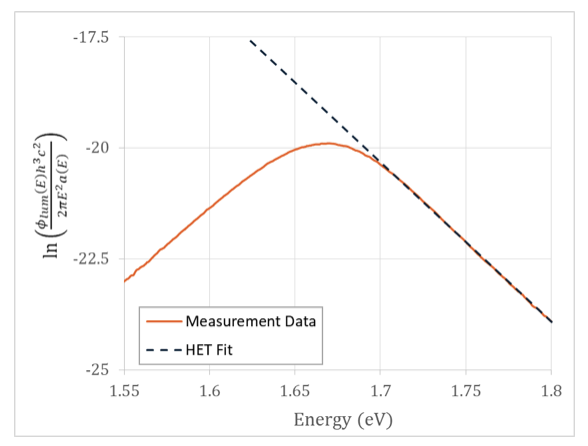LuQY Pro – Theory
Absolute PL / EL characterization
LuQY calculation of electro-/ photoluminescence quantum yield
The external luminescence quantum yield LuQY (also electro-/ photoluminescence quantum yield ELQY / PLQY or external quantum yield η) is calculated by dividing the absolute PL and EL emission by the excitation:

where Φlum = absolute PL / EL flux density, E = photon energy, Φexc = excitation photon flux density (laser in LuQY Pro), Φexc,R = non-absorbed excitation photon flux density (reflected laser in LuQY Pro), ISMU = current sourced by the SMU. Note, that sinked current is not taken into account for the LuQY calculation, i.e. PL emission at short circuit condition will yield a lower LuQY than emission at open circuit (assuming that luminescence is quenched by extraction of charge carriers at short circuit current).
Implied open circuit voltage prediction

Fig. 1. Exemplary absolute PL data and high energy tail fit (HET fit)
The implied VOC (iVOC, also QFLS quasi-Fermi level splitting) can be determined by a high energy tail fit method to the absolute PL / EL emission flux:

where = absolute PL / EL flux density, E = photon energy, h = Planck constant, c = speed of light, a = absorptance of sample, q = electric charge, k = Boltzmann constant, T = Temperature of electron gas. An exemplary graph is shown in figure 1.The intersection of the fitted line with the ordinate at 0 eV yields q*iVOC/k/T
Absolute calibration of the system
Prerequisite for the high energy tail fit method is a calibration of the entire measurement system to absolute photon numbers (absolute PL / absolute EL).
The laser intensity of the LuQY Pro is calibrated to absolute photon numbers against certified power meters. The spectral sensitivity of the LuQY Pro is calibrated to absolute photon numbers against certified reference lamps with known luminous flux as well as against different lasers with intensities determined by a certified power meter.
All measurement equipment used for calibration is traceable to national standards of the ‘EUROMET’ members (NPL, PTB, BNM etc.), the US ‘NIST’ or other national metrological institutions. Measurements which cannot be traced to national standards can be traced to natural constants, other accepted standards or relational measurements. All calibrations are valid for one year.
More details on absolute PL / EL analysis can be found here:
[1] Unold, T.; Gütay, L. Photoluminescence Analysis of Thin-Film Solar Cells. In Advanced Characterization Techniques for Thin Film Solar Cells; Wiley-VCH Verlag GmbH & Co. KGaA, 2011; pp 151–175.
[2] Kirchartz, T.; Márquez, J. A.; Stolterfoht, M.; Unold, T. Photoluminescence‐Based Characterization of Halide Perovskites for Photovoltaics. Adv. Energy Mater. 2020, 1904134.
[3] Swartz, C.; Paul, S.; Mansfield, L.; Holtz, M. Absolute photoluminescence intensity in thin film solar cells. Journal of Applied Physics 125, 053103, 2019.

